The Middle Rhine River in Germany is famed for its breathtaking landscapes adorned with charming medieval castles. We’ve had the privilege of admiring many of these ancient fortresses, both from the vantage point of the Rhine and up close during two visits spanning over a decade. Whether you’re cruising along the river or traversing the quaint towns and vineyard-covered hillsides, you’ll be greeted by a plethora of castles situated atop rocky cliffs or nestled within picturesque villages.
These castles only offer a glimpse into Germany’s medieval past. Many of them are open to the public for tours, allowing you to explore their history, architecture, and scenic surroundings including numerous hillside vineyards producing the world’s best Riesling wines. Whether you’re interested in history, architecture, or simply enjoying the beauty of the so-called Romantic Rhine Valley, these castles offer a memorable experience along one of Europe’s most picturesque river routes.
Jump to a specific area.
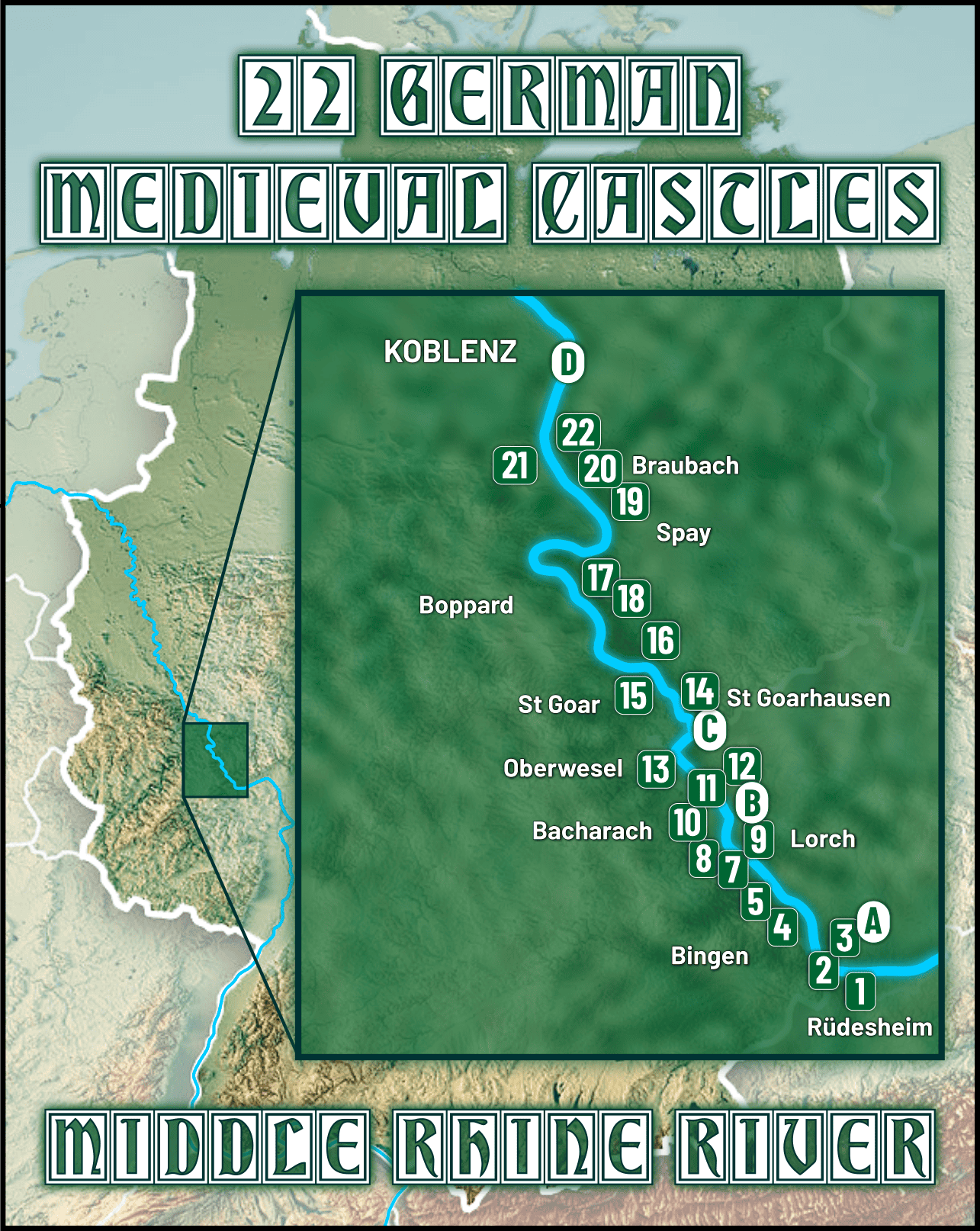
Apart from the castles, you’ll discover charming towns, significant German landmarks, and magnificent viewpoints. In fact, this entire region was named a UNESCO World Heritage Site in 2002. We invite you to explore our list, starting from Rüdesheim and heading northward to Koblenz, featuring 22 medieval castles along the Middle Rhine River in Germany.
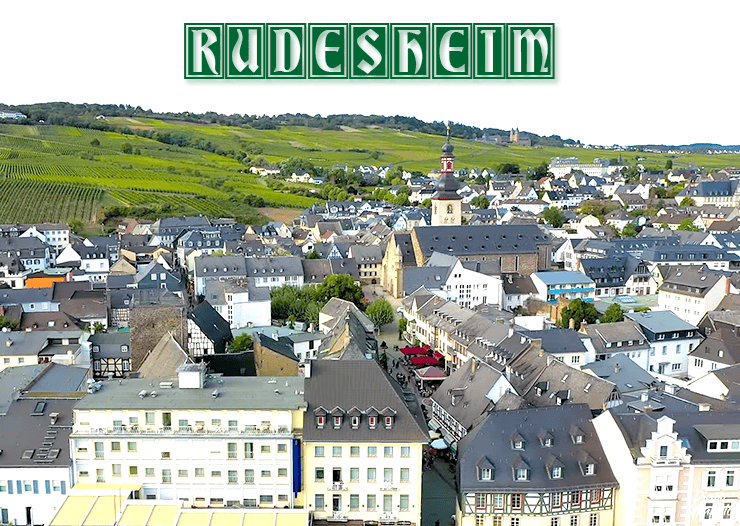
Rüdesheim, a charming town nestled along the banks of the Rhine River in Germany, is a picturesque destination renowned for its stunning landscapes, rich history, and world-class wine. Its quaint streets lined with half-timbered houses exude a timeless charm, inviting visitors to wander and explore. One of the town’s most iconic attractions is the Drosselgasse, a narrow cobblestone alley brimming with lively wine taverns, restaurants, and shops, where locals and tourists alike gather to enjoy the region’s finest wines and traditional German cuisine. The town is famous for producing Riesling wine, is home to the world’s largest cuckoo clock and one of Germany’s oldest Christmas markets.
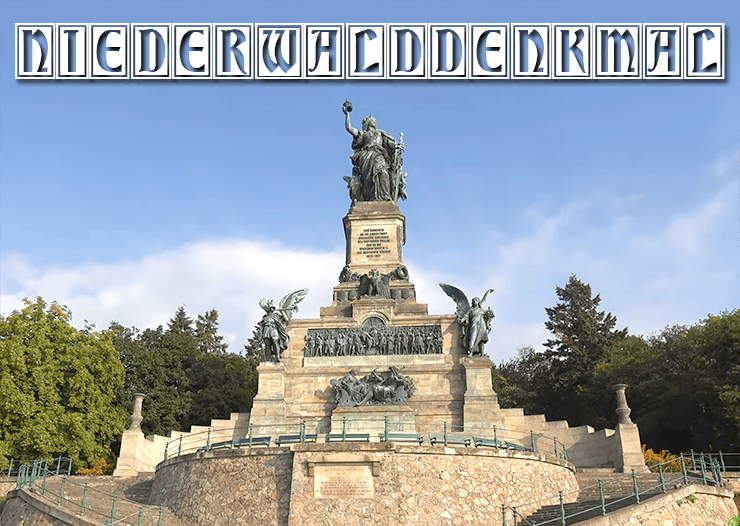
Near the east end of the Drosselgasse is a chair lift that can take you up to one of Germany’s most important monuments. The Niederwald Monument, perched atop the Niederwald hill overlooking the Rhine Valley, stands as a symbol of German unity and freedom. Constructed in the late 19th century, the monument commemorates the unification of Germany after the Franco-Prussian War of 1870-1871. Towering at 38 meters tall, it features a massive bronze statue depicting Germania, the personification of the German nation, holding the Imperial Crown and the Imperial Sword. The monument is impressive but its really the panoramic views of the Middle Rhine River winding through the picturesque valley below that make the journey worthwhile.
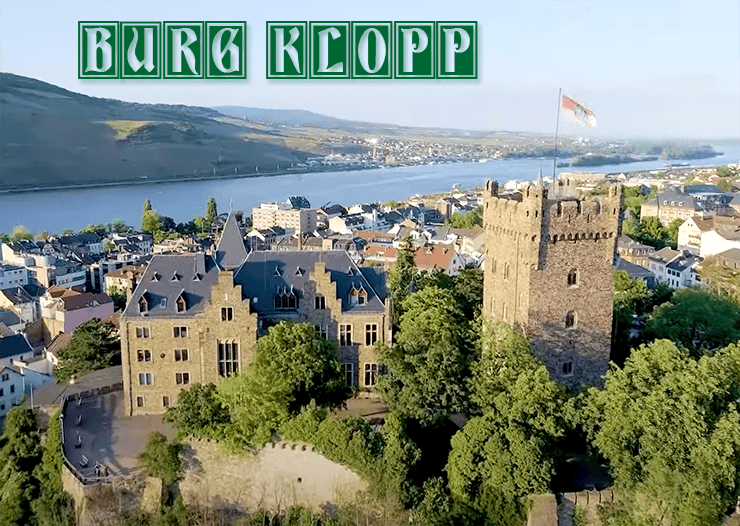
Burg Klopp stands as a testament to medieval architecture and history. Perched atop a hill overlooking the Middle Rhine River, this imposing fortress was originally constructed in the early 1200s. The fortress served as a strategic stronghold overlooking the Rhine River. Its primary purpose was to safeguard the surrounding lands and control river traffic, thus playing a crucial role in regional defense and trade. By the 17th and 18th centuries, Burg Klopp had lost its military significance and gradually fell into disrepair. However, it was later restored and re-purposed for civilian use.
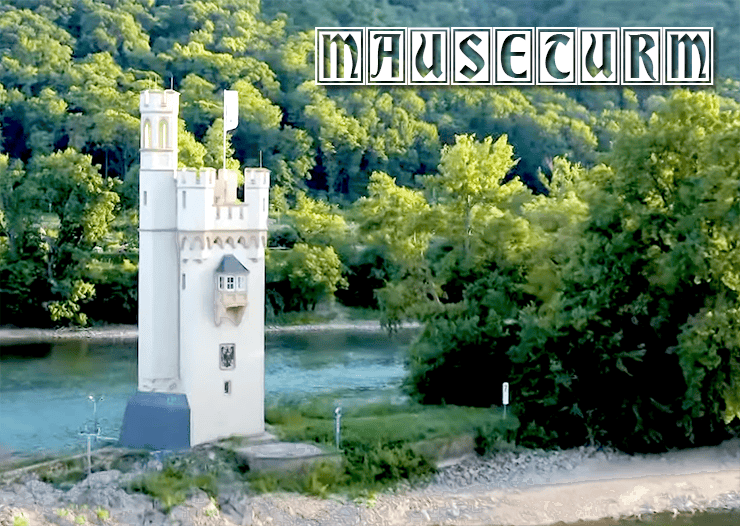
The Mäuseturm, or Mouse Tower, is a distinctive tower situated on a small island in the Middle Rhine River near Bingen, Germany. With origins dating back to the 10th century, the tower has a fascinating legend attached to it. According to local folklore, the Archbishop of Mainz, Hatto II, sought refuge in the tower during a famine in the 10th century. However, as the legend goes, he was overrun by a horde of mice, driving him to his demise. The tower was later rebuilt and served various purposes over the centuries, including as a toll station and a lighthouse. Today, the Mäuseturm stands as a prominent landmark, offering visitors a glimpse into the rich history and folklore of the region.
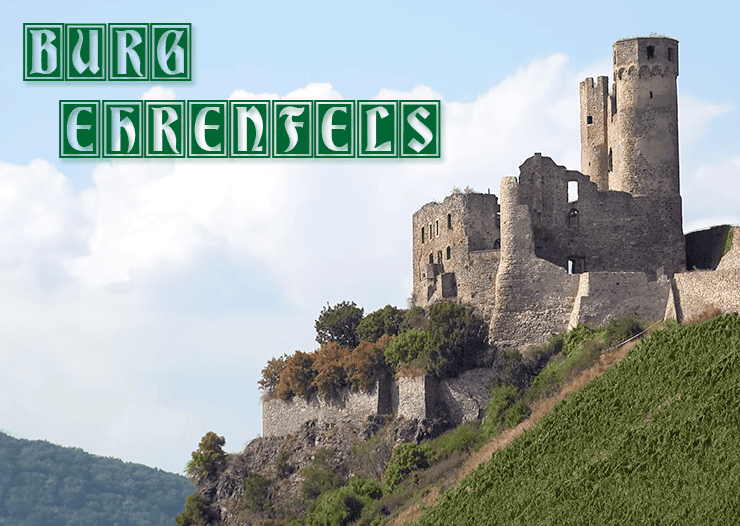
Nestled along the banks of the majestic Middle Rhine River, this iconic castle, dating back to the 12th century, holds within its walls centuries of tales and legends. Burg Ehrenfels served as a toll station controlling river traffic bearing witness to countless battles and sieges. Legend tells of a mysterious ghostly figure that supposedly roams its halls, adding an extra layer of mystique to this already enchanting fortress. Explore the winding corridors, climb the weathered stone steps of the tower, and marvel at the breathtaking views of the surrounding vineyards and villages below.
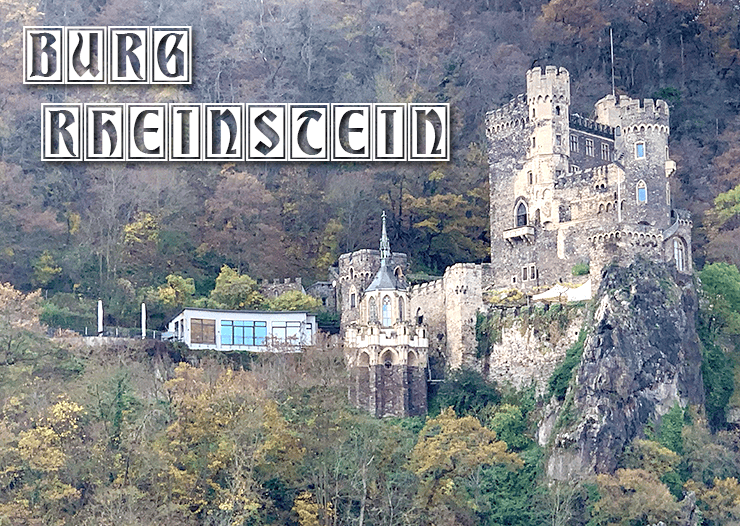
Built in the 14th century, Burg Rheinstein’s imposing towers and sturdy walls have stood the test of time, witnessing centuries of political intrigue and warfare. Overlooking the Middle Rhine River, the castle offers breathtaking views of the surrounding vineyards and quaint villages. Its well-preserved interiors, including the knights’ hall and living quarters, have made it a popular location for film and television productions. According to local folklore, the castle was constructed by a robber knight named Falkenburg, who fell in love with a beautiful maiden from the neighboring Burg Reichenstein. To win her hand in marriage, he built Burg Rheinstein in just one night, using stones carried by the Middle Rhine River’s current.
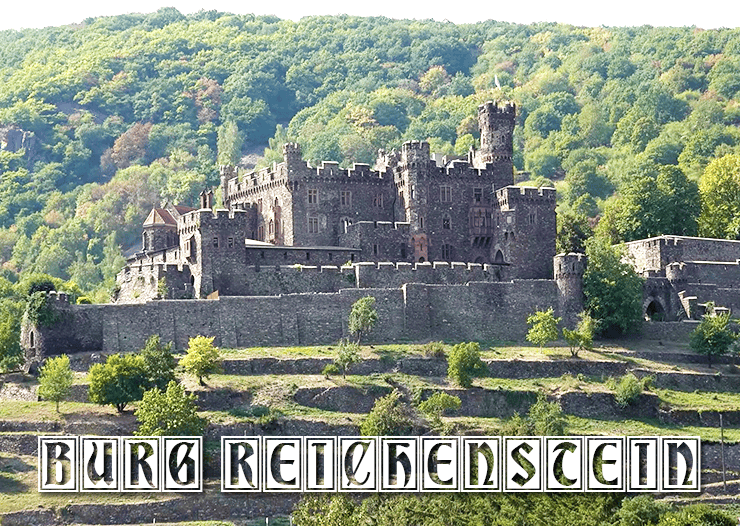
Burg Reichenstein is a massive medieval castle steeped in history and heritage. Dating back to the 11th century, the castle has witnessed centuries of political intrigue, battles, and noble aspirations. Over the centuries, Burg Reichenstein has hosted illustrious guests, including Emperor Frederick Barbarossa and King Richard the Lionheart of England. Burg Reichenstein has its share of ghostly tales and legends. One such legend tells of the “White Lady,” a ghost said to roam the castle’s halls, believed to be the spirit of a noblewoman who tragically lost her life within its walls centuries ago. Today, the castle serves as a hotel and restaurant.
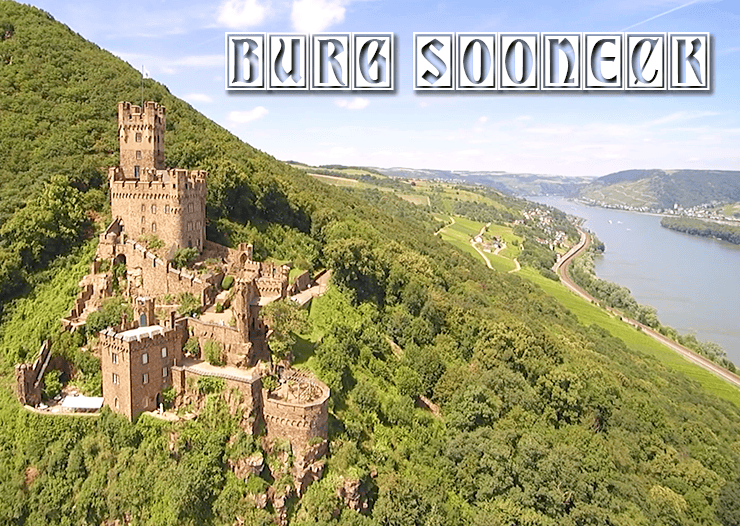
Burg Sooneck was built in the 13th century, the castle’s strategic location afforded it a prominent role in the defense of the region and control of river traffic. In the 14th century, it was attacked and partially destroyed by a coalition of knights in retaliation for its lord’s aggressive actions against neighboring territories. This event, known as the “Feud of Sooneck,” illustrates the castle’s involvement in the turbulent politics of the time. In the 19th century, Burg Sooneck underwent extensive restoration thanks to the efforts of the Prussian Crown Prince, Frederick William IV. Be sure to keep an eye out for a ghostly white lady who is said to wander the castle’s halls, believed to be the spirit of a noblewoman who tragically lost her life within its walls centuries ago.
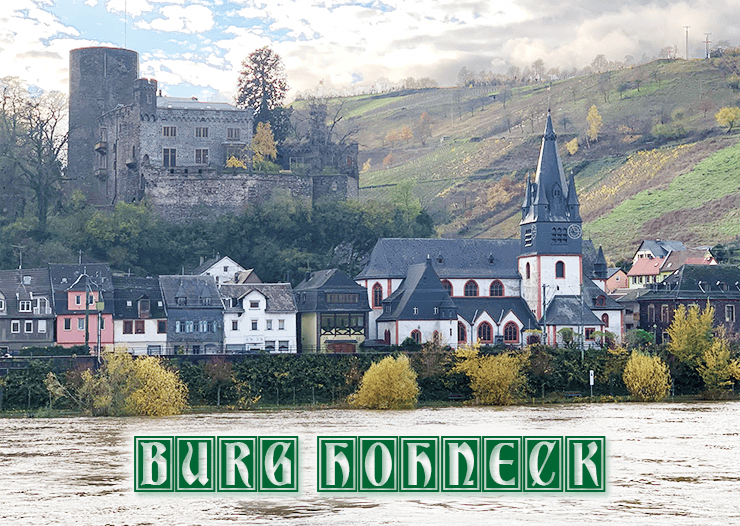
Burg Hohneck, commanding a view over the Middle Rhine River and the picturesque St. Mariae Himmelfahrt church, underwent significant restoration in the 19th century, led by architect Gustav Bockelheim. This endeavor revitalized the castle into the neo-Gothic style known today, merging modern romanticism with its medieval roots. One of its towers is rumored to have influenced the tale of Rapunzel, lending an air of enchantment to the castle’s already captivating presence. Throughout the year, Burg Hohneck is a vibrant cultural hub, hosting a variety of events such as medieval festivals, concerts, and theatrical performances.
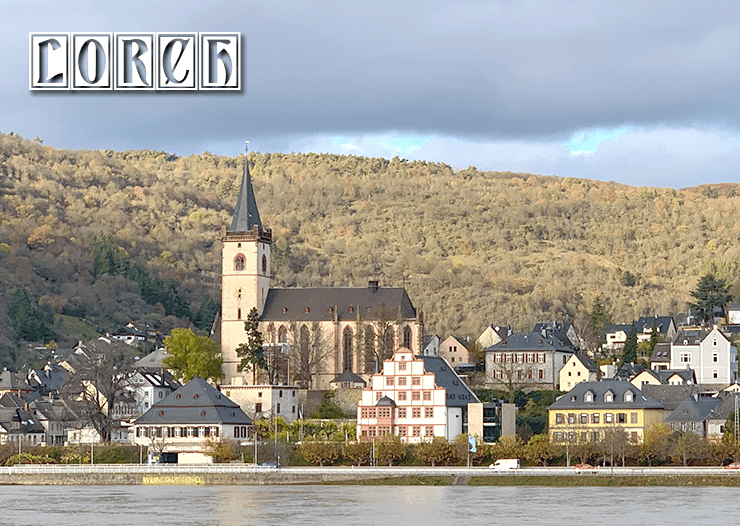
Enveloped by rolling hills adorned with vineyards and forests, the German town of Lorch offers a serene escape along the Middle Rhine River. The town is renowned for its enchanting “Heinrich Fountain,” steeped in local folklore surrounding Heinrich der Vogler’s legend. According to the tale, a pact with the devil led to the fountain’s creation, imbuing its waters with mystical allure, captivating visitors. Lorch’s cultural tapestry is further enriched by St. Martin’s Church, an architectural gem erected in the 12th century. Serving as a revered pilgrimage destination, the church’s resplendent design and religious significance imbue the town with a profound spiritual essence, making it a cherished cultural landmark.
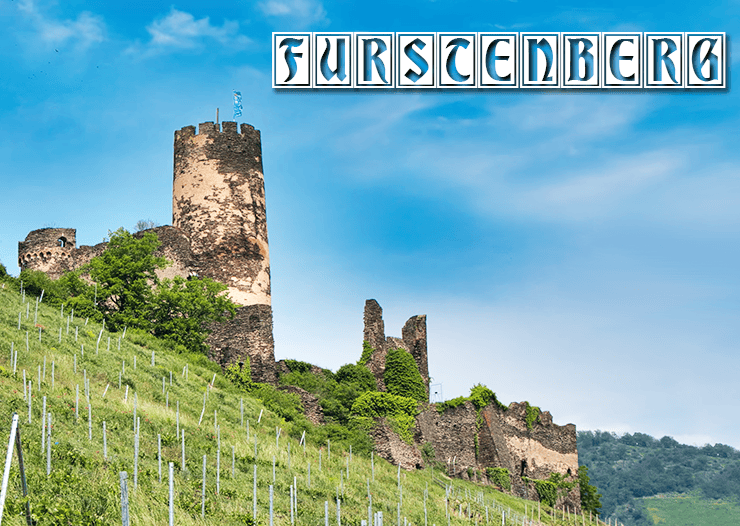
Perched majestically atop a hill overlooking the Middle Rhine River, lies the Ruine Burg Fürstenberg (the ruins of Fürstenberg Castle), a captivating medieval castle steeped in history and intrigue. Dating back to the 12th century, this imposing fortress once served as a strategic stronghold along the banks of the Rhine River. Though now in ruins, its weathered stone walls and crumbling towers was once the ancestral seat of the noble von Fürstenberg family, who played a significant role in the political and cultural landscape of the region during the Middle Ages.
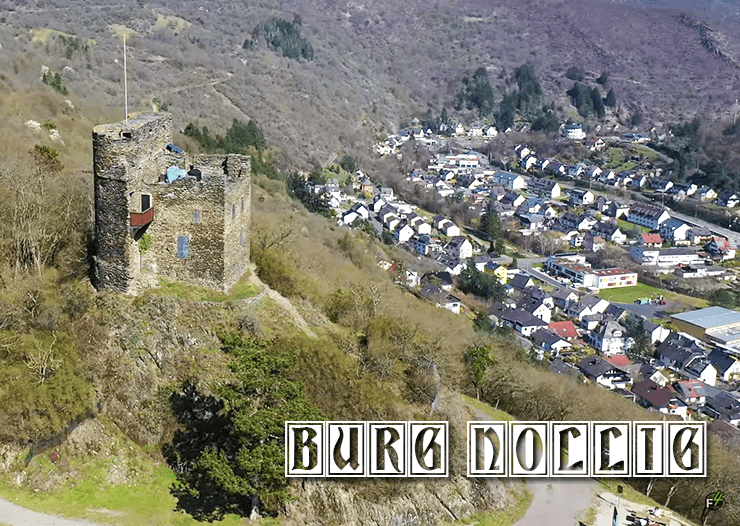
Perched proudly on a hill overlooking the picturesque town of Lorch, Germany, stands the historic Burg Nollig. Dating back to the 11th century, Burg Nollig has undergone several transformations, serving various purposes including as a defensive fortress, a noble residence, and even as a quarry for local construction projects. Like many medieval castles, Burg Nollig is shrouded in legends and folklore. One tale recounts a mysterious underground tunnel supposedly connecting Burg Nollig to nearby Lorch, adding an air of mystery to the castle’s past.
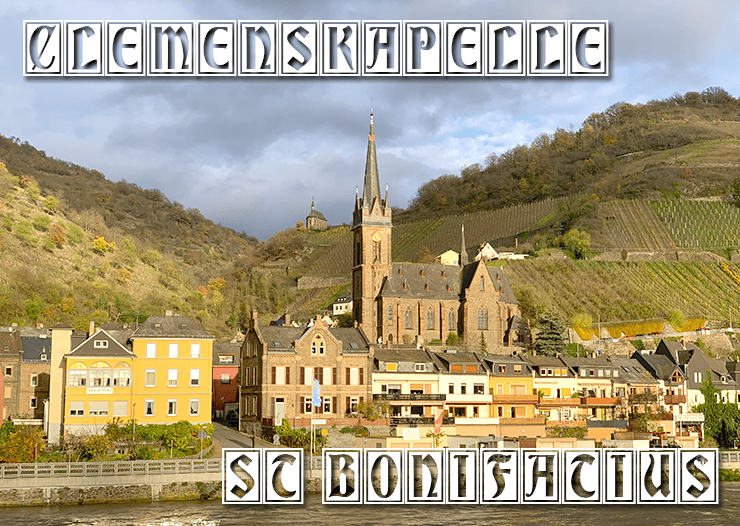
As you move further north along the Middle Rhine River you’ll come to the magnificent Neo-Gothic St. Bonifatius Catholic Church named for the renowned missionary and saint who played a pivotal role in the Christianization of Germanic tribes during the 8th century. High up on the hill overlooking the scenic Rhine Valley, sits the Clemenskapelle or the Chapel of St. Clemens. St. Clemens is often associated with compassion, healing, and protection, making the chapel a place of solace and hope for worshipers and simple visitors alike.
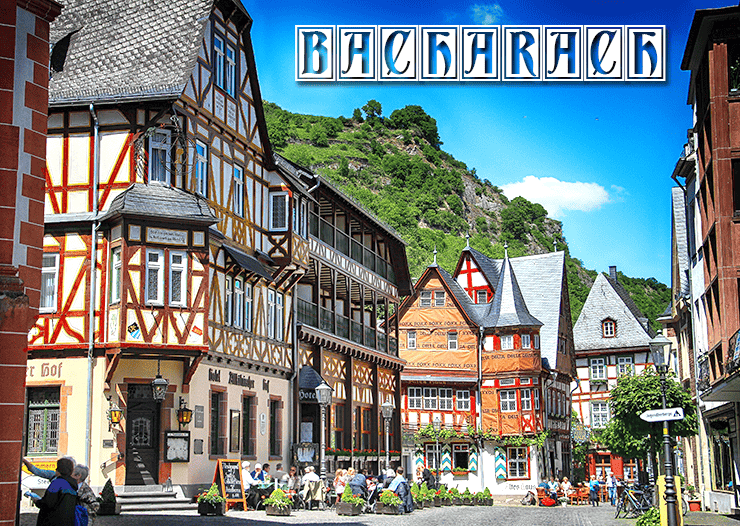
Nestled along the banks of the Middle Rhine River, Bacharach is a picturesque town renowned for its medieval charm and stunning riverside setting. With its well-preserved half-timbered houses, winding cobblestone streets, and historic landmarks, Bacharach exudes a timeless ambiance that captivates visitors. The town is steeped in history, with roots dating back to Roman times, and boasts an array of attractions, including the imposing Stahleck Castle, the romantic ruins of Werner Chapel, and the charming Market Square. Bacharach also serves as a gateway to the renowned Rhine Gorge, a UNESCO World Heritage Site known for its scenic beauty and vineyard-covered slopes.
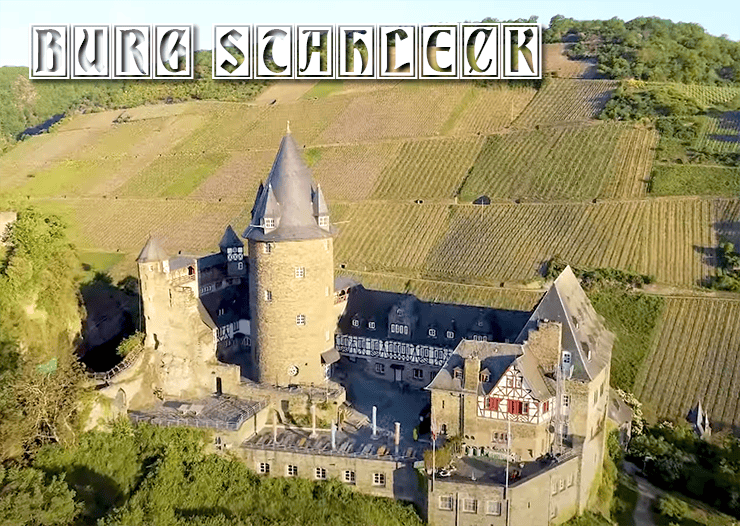
Burg Stahleck, overlooking the picturesque town of Bacharach, offers breathtaking panoramic views of the surrounding vineyards and the Middle Rhine River. Originally built by the Archbishop of Cologne in the 12th century, it was later owned by various noble families before becoming a property of the state of Rhineland-Palatinate in the 20th century. Since 1925 the castle has served as a youth hostel while also hosting various international events, including medieval festivals, concerts, and educational programs. Despite facing damage and destruction during various conflicts, including the Thirty Years’ War and World War II, Burg Stahleck has been faithfully restored each time.
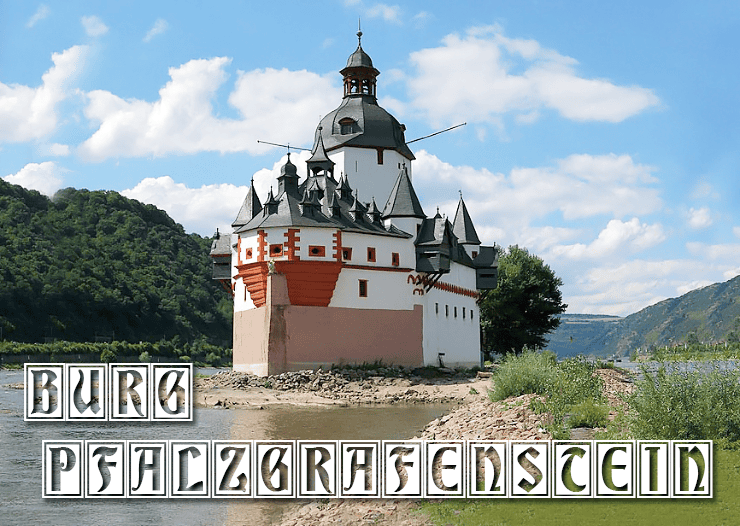
Perched upon a small island amidst the flowing waters of the Middle Rhine River, Burg Pfalzgrafenstein stands as a remarkable testament to medieval ingenuity and practicality. Constructed in the 14th century under the patronage of King Ludwig the Bavarian, this castle served a pivotal role as a toll station. Positioned strategically, it controlled river traffic and exacted tolls from passing ships through the clever use of extended metal chains connected to each shore, effectively halting any vessel’s passage. Its isolated island location rendered it nearly impregnable, a feat further enhanced by its ingenious design. Despite its modest dimensions, Burg Pfalzgrafenstein was outfitted with essential amenities including living quarters, a chapel, a well, and even a torture chamber, underscoring the mastery of medieval engineering at its finest.
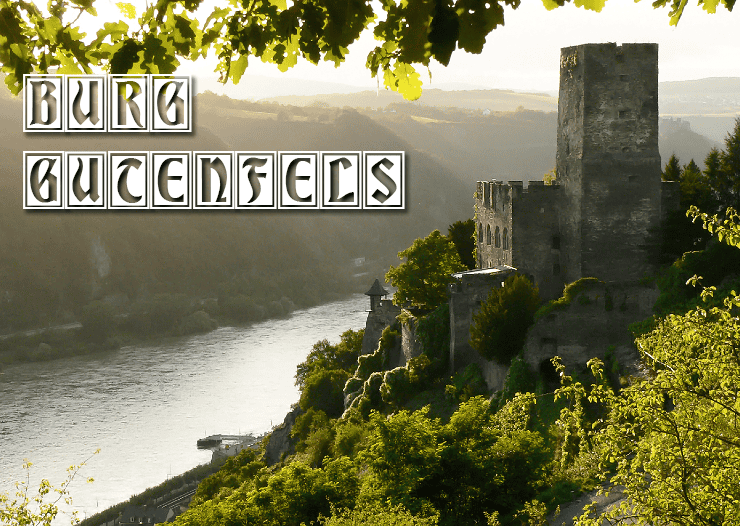
Gutenfels Castle, also referred to as Caub Castle, is a striking medieval fortress nestled atop a hill overlooking the Middle Rhine River. Constructed in 1220 by the lords of Falkenstein-Münzenberg, it played a crucial role alongside Pfalzgrafenstein Castle in controlling river traffic and toll collection on the Rhine. Together with the fortified town of Kaub, they formed an impenetrable toll zone for the Holy Roman Emperor until Prussia’s acquisition of the area in 1866, leading to the cessation of toll collection in 1867. Situated within the Rhine Gorge, Gutenfels Castle was designated a UNESCO World Heritage Site in 2002. Like many historic castles in Germany, Burg Gutenfels has been repurposed for modern use. Today, it has been transformed into a charming hotel.
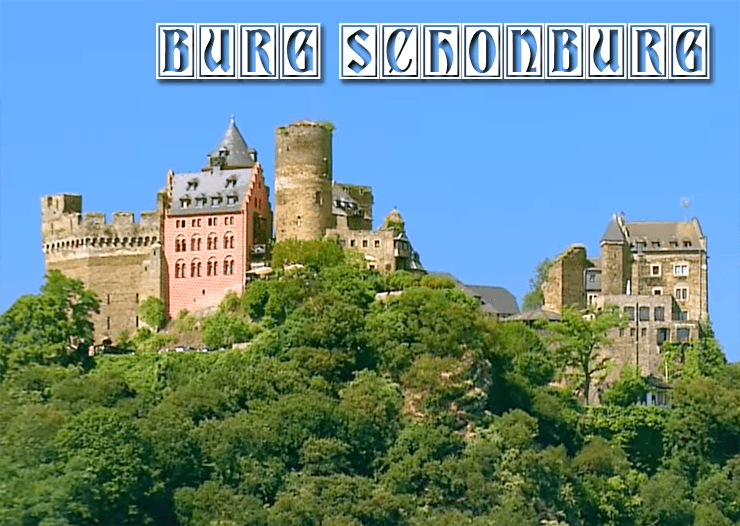
Schönburg Castle, perched above Oberwesel in Germany’s UNESCO-listed Upper Middle Rhine Valley, traces its roots to between 911 and 1166. The Lords of Schönburg, who ruled Oberwesel from the 12th century, held the right to levy customs on the Rhine River. Notable among them was Friedrich von Schönburg, also known as “Marshall Schomberg,” who served as a military leader in various European countries. The castle was destroyed in 1689 during the War of the Grand Alliance but was later restored by the German-American Rhinelander family in the late 19th century. Since 1957, the Hüttl family has inhabited the castle, running it as a successful hotel and restaurant.
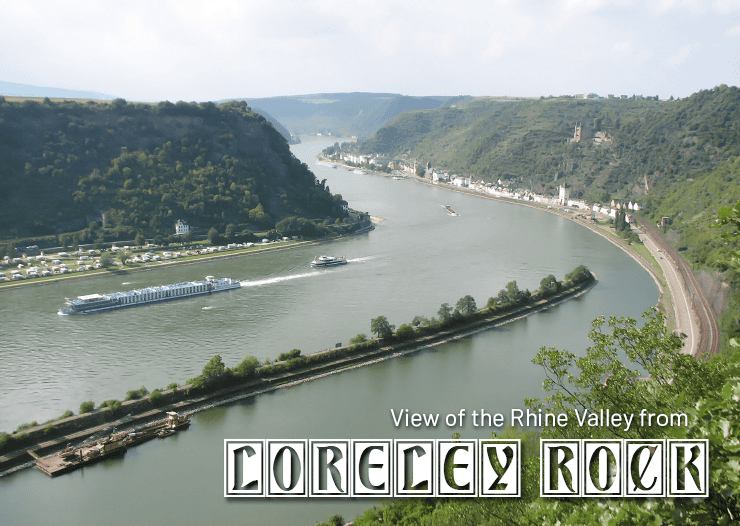
Loreley, a legendary siren of German folklore, is associated with the picturesque Loreley Rock overlooking the Rhine River. Loreley Rock, also known as Lorelei, is a steep slate cliff rising about 433 feet (132 meters) above the Middle Rhine River. According to myth, Loreley was a beautiful maiden who would sit atop the rock, combing her golden hair and singing enchanting melodies that lured sailors to their doom. The treacherous currents and jagged rocks near Loreley Rock have led to numerous shipwrecks throughout history, contributing to the lore surrounding the mythical figure. The last bus leaves the top at 5 pm. If you miss it there are 350 rather steep stairs (as we found out the hard way) that descend all the way down to the water.
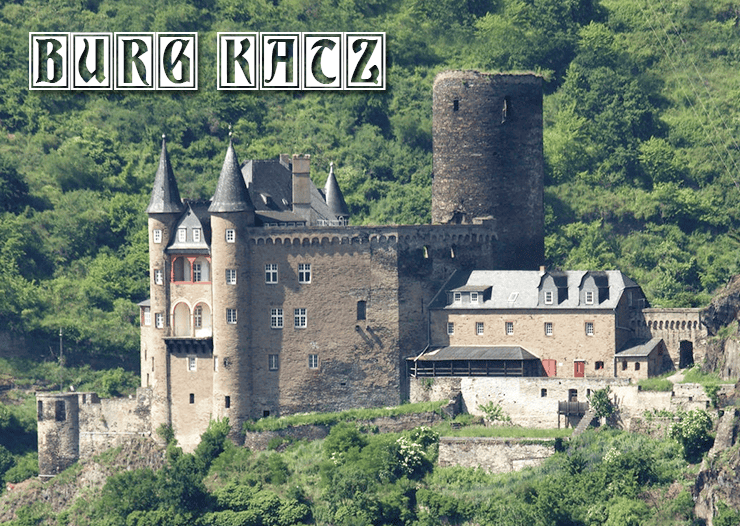
Situated proudly above the town of St. Goarshausen in Germany, Burg Katz stands as a remarkable medieval fortress rich with history. Constructed in the 14th century under the patronage of Count Wilhelm II of Katzenelnbogen, its name, meaning “Cat Castle,” pays homage to its noble lineage. Despite enduring damages from conflicts like the Thirty Years’ War and the Palatine War of Succession, extensive restoration efforts in the 19th century preserved the castle’s architectural grandeur. Infused with legends and folklore, Burg Katz captivates visitors with tales of knights wielding magical cloaks, adding to its mystical allure.
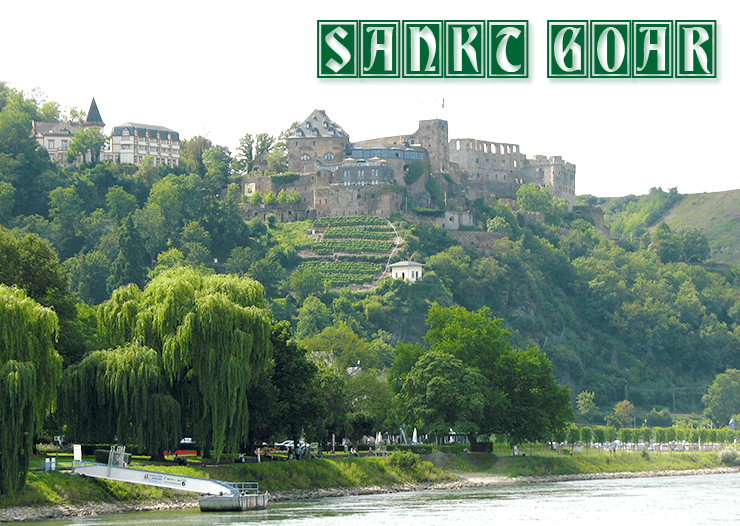
St. Goar, also known as Sankt Goar, is a charming town renowned for its picturesque beauty and rich history. Nestled amidst lush vineyards and rolling hills, St. Goar boasts a quaint old town filled with traditional half-timbered houses, cobblestone streets, and historic landmarks. One of its most notable attractions is Rheinfels Castle, a majestic fortress perched atop a hill overlooking the town and the Rhine Valley. St. Goar also serves as a gateway to the UNESCO-listed Upper Middle Rhine Valley, where visitors can embark on scenic cruises along the river or hike through the vineyard-clad hills. On the opposite side of the Rhine Gorge is St. Goarshausen which, loosely translated, means where the homes of St. Goar are located.
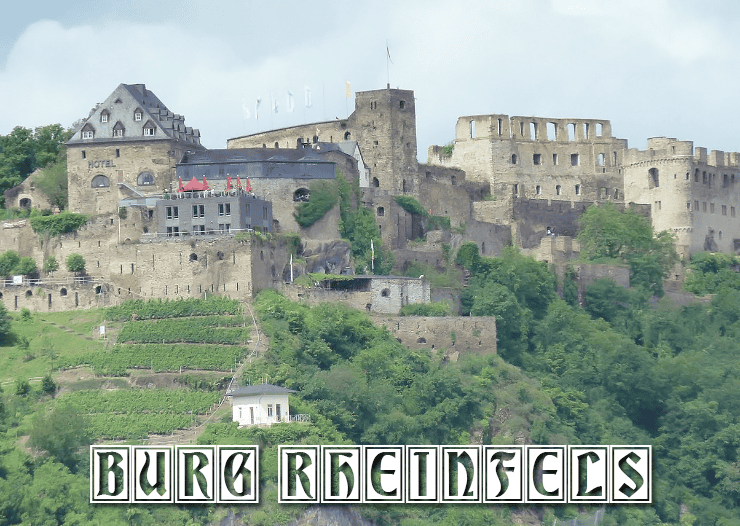
During the Medieval ages, Burg Rheinfels stood as the largest fortress along the Middle Rhine River. Built in the 13th century by Count Diether V of Katzenelnbogen, it operated as a crucial stronghold safeguarding the Rhine River. Featuring formidable walls, towers, and a network of underground tunnels known as the “catacombs,” Burg Rheinfels played a pivotal role in both defending the region and regulating river traffic. Despite enduring destruction during the Palatine War of Succession in the late 17th century, the castle remains a sought-after tourist destination, offering guided tours and exhibits that provide insight into its rich history. Today, Burg Rheinfels stands as the region’s premier tourist attraction, also serving as a hotel, restaurant, and gift shop, providing visitors with a comprehensive experience of its storied past.
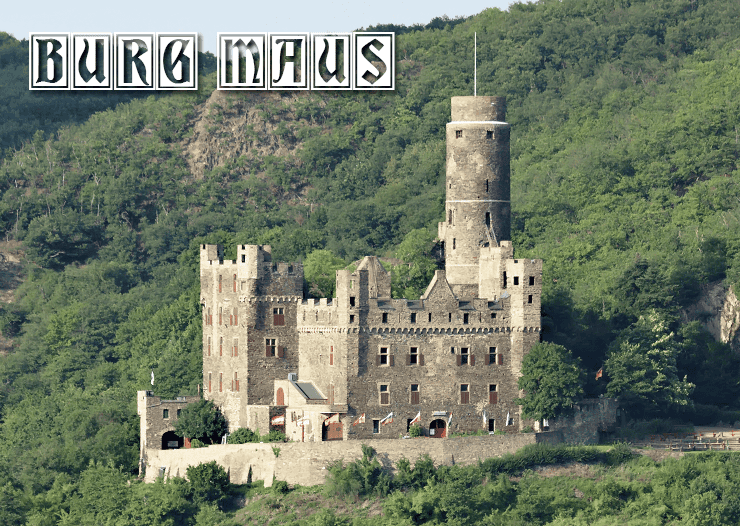
Perched atop a hill with commanding views of the Middle Rhine River, Burg Maus (Mouse Castle) was constructed in the 14th century under the patronage of Archbishop Balduin of Trier. Ironically, despite receiving its name as an insult from the Counts of Katzenelnbogen of Burg Katz, Burg Maus remained remarkably intact throughout history, evading destruction. Although it endured additional damage from neglect and shelling during World War I, it was meticulously restored in the early 20th century by architect Wilhelm Gärtner. Today, Burg Maus serves as an aviary for falcons, owls, and eagles, delighting visitors with flight demonstrations staged from late March to early October.
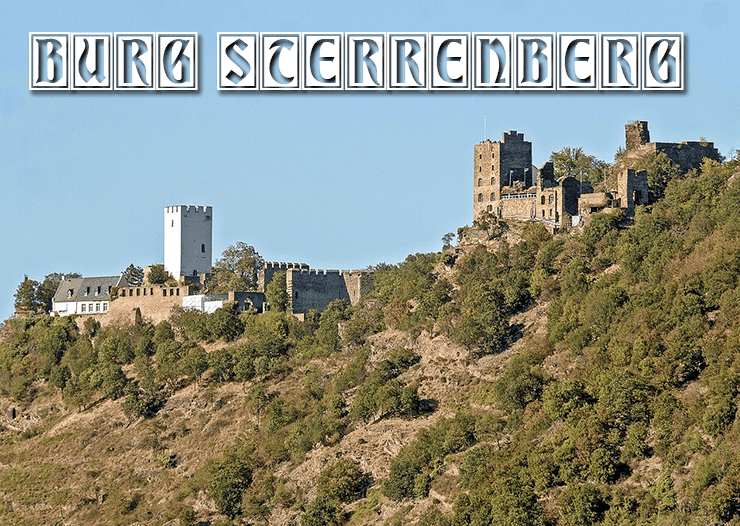
Constructed in the 12th century by the Counts of Leyen, Burg Sterrenberg played a vital role in guarding the strategic Middle Rhine River trade routes. Burg Sterrenberg is famously known as one of the “sister castles” along with nearby Burg Liebenstein. These two castles were built by two brothers and were strategically positioned to guard the Rhine River together. They are often referred to as the “Hostile Brothers” due to their rivalry. Like many castles along the Rhine, Burg Sterrenberg is steeped in legends and folklore. One popular tale tells of a ghostly White Lady who is said to haunt the castle’s halls, adding to its mysterious allure. After periods of neglect and decay, Burg Sterrenberg underwent extensive restoration efforts in the 19th century, preserving its medieval character and architectural integrity. Today, visitors can explore its well-preserved rooms, towers, and battlements.
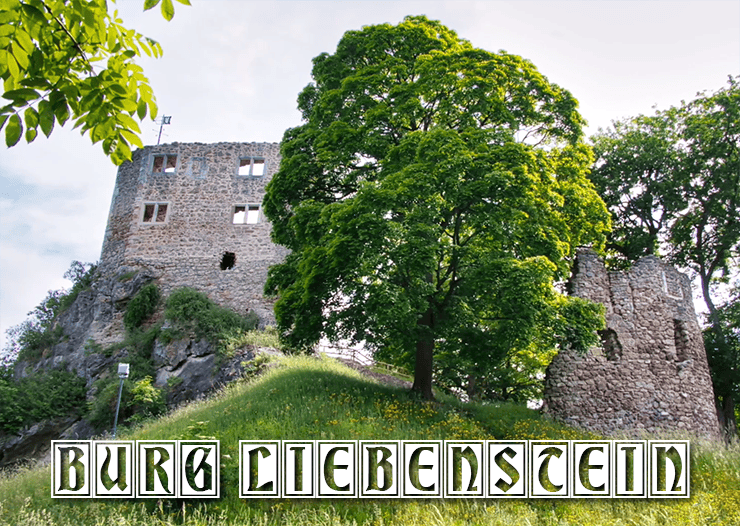
Liebenstein Castle, dating back to the 13th century, shares a legendary tale with Sterrenberg Castle, earning them the nickname “Feuding Brothers.” This rivalry enhances their reputation among the Middle Rhine River castles. Stemming from 1320, when Sterrenberg Castle came under the Archbishopric of Trier’s control, Liebenstein Castle became the retreat for its lords. The imposing shield wall at Sterrenberg Castle stands as a testament to their longstanding animosity. Additionally, Liebenstein Castle transitioned into a Ganerbenburg in 1340, accommodating multiple noble families. Today, Liebenstein Castle, with its hotel and restaurant, reflects the remnants of this communal living setup after extensive renovations in 1977.
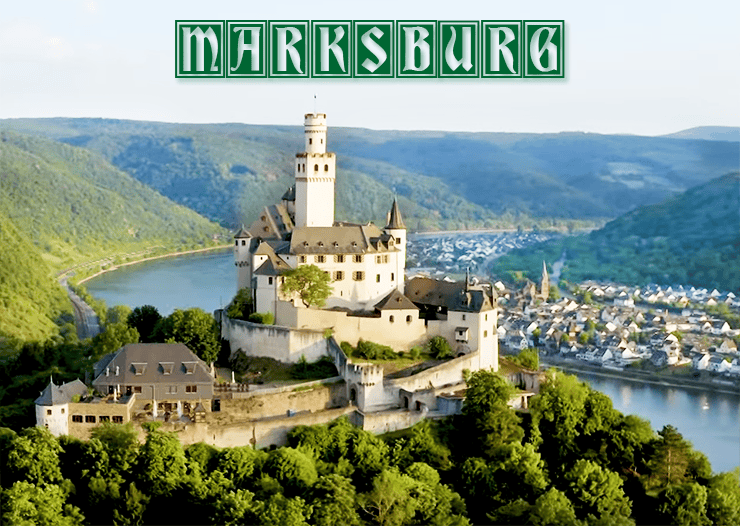
Perched proudly above the town of Braubach, Marksburg Castle dates back to the 12th century. Marksburg is the only hilltop castle along the Middle Rhine River that has never been destroyed, making it a unique architectural treasure. With its formidable walls, towers, and fortified battlements, the castle served as a vital defensive stronghold guarding the region and controlling trade routes. Today, visitors can explore its well-preserved chambers, armories, and courtyards, gaining insights into medieval life and warfare. Each year, Marksburg Castle hosts a medieval knights’ tournament, where participants compete in jousting, sword fighting, and other traditional medieval games.
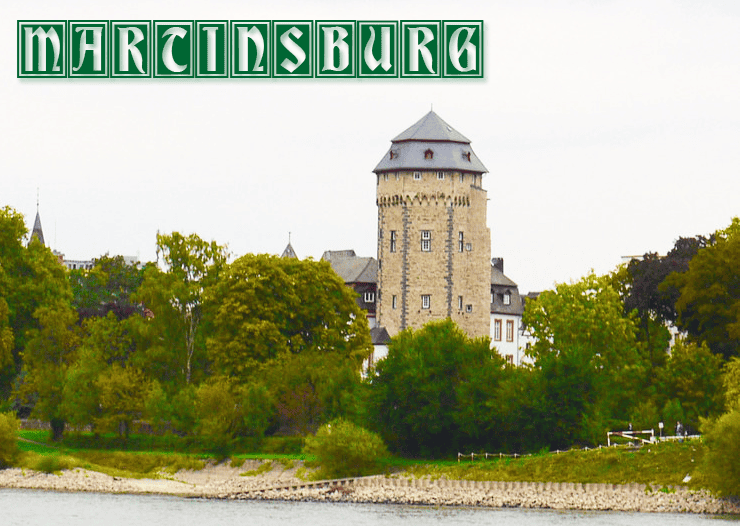
Nestled in the enchanting town of Boppard along the picturesque Middle Rhine River, Martinsburg is a mesmerizing medieval fortress steeped in centuries of history. Dating back to the 14th century, you can ascend the castle’s towers and battlements, treating yourself to awe-inspiring views of the idyllic Rhine Valley below. Additionally, Martinsburg hosts a fascinating Wine Cellar Museum, offering insight into the area’s rich viticultural past. Here, you can delve into the world of winemaking, exploring ancient tools and barrels while learning about traditional wine production methods. Adding to its allure, Martinsburg is enveloped in legends and ghostly tales, with whispers of a spectral White Lady haunting its halls, imbuing the fortress with an air of mystery and intrigue.
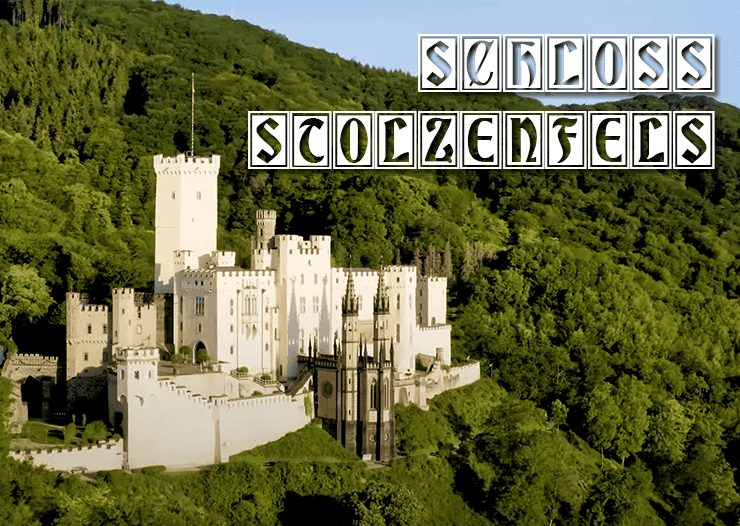
Schloss Stolzenfels, a magnificent castle nestled along the banks of the Rhine River near Koblenz, Germany, is a stunning example of Rhine Romanticism architecture. Originally constructed in the 13th century, the castle underwent extensive renovations in the 19th century under the patronage of King Frederick William IV of Prussia, transforming it into a grandiose palace. With its picturesque setting, opulent interiors, and meticulously landscaped gardens, Schloss Stolzenfels became a favored residence of Prussian royalty and visiting dignitaries. Today, visitors can explore its lavishly decorated rooms, admire its panoramic views of the Middle Rhine River, and stroll through its manicured grounds, experiencing the splendor of this historic landmark firsthand.
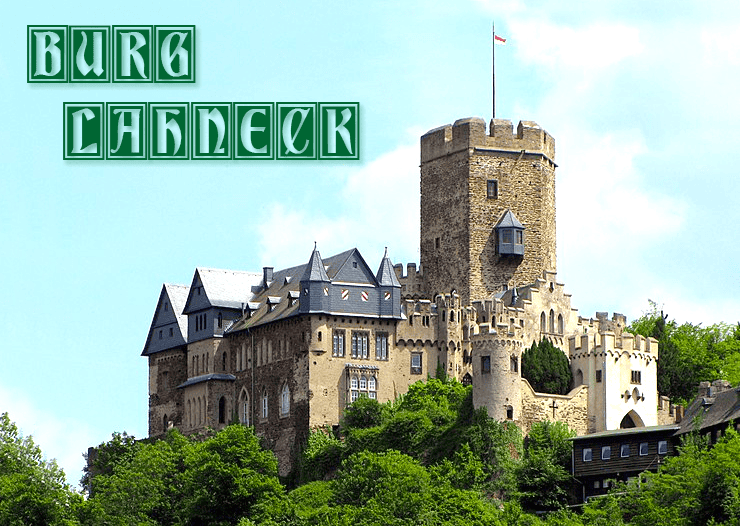
Burg Lahneck, built in the 13th century overlooking the Middle Rhine River, served as a strategic fortress at the confluence of the Rhine and Lahn rivers. Its imposing towers and sturdy walls controlled river traffic and defended against threats. Over the centuries, it hosted notable figures like Emperor Frederick III and underwent 19th-century renovations directed by Prussian King Frederick William IV. Today, Burg Lahneck is a popular tourist spot, offering guided tours and panoramic views of the Rhine Valley, making it a must-visit for history enthusiasts and travelers.
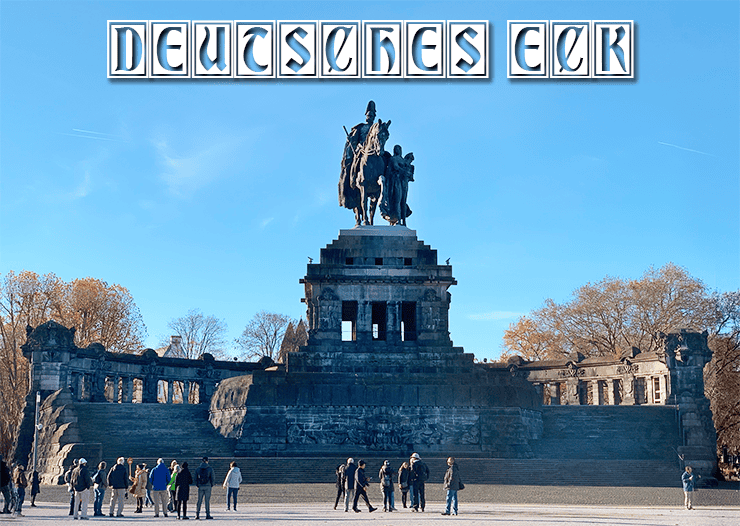
Deutsches Eck, translated as “German Corner,” is a historic landmark located in the city of Koblenz, Germany, where the Moselle River joins the Middle Rhine River. The name “German Corner” originates from the German Empire’s foundation in 1871, marked by the installation of a monumental equestrian statue of Kaiser Wilhelm I at the site. The statue was later destroyed during World War II but reconstructed in 1993 as a symbol of German unity. Today, Deutsches Eck is a popular tourist destination, offering stunning views of the rivers and serving as a gathering place for locals and visitors alike. Near the monument is the Seilbahn Koblenz with cable cars that can take you over the Rhine up to the Fortress Ehrenbreitstein which hosts several events each year.
Have you been to any of the Medieval Castles along the Rhine? Did you see them on a River Cruise? How many did you get to visit in person?
We’d love to hear about your adventures so please leave us a Comment below. Thank you and happy travelling!

